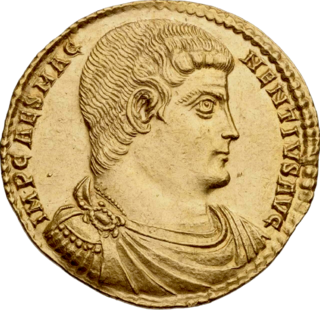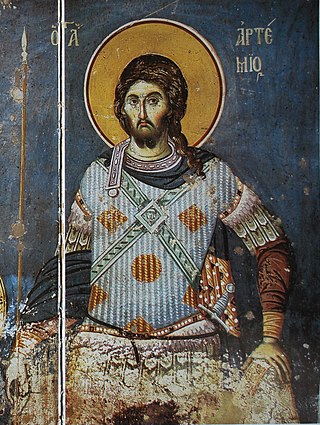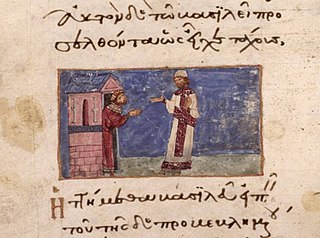Biography
Background, reputation, and general character
Little is known of Paulus' personal life or background. He was a native of Spain [note 3] and Marcellinus reports that he had a "smooth countenance." [10] Before obtaining his position as an imperial aid, he was a steward of the emperor's table. The exact office he held while in the emperor's service is unclear: Modern sources follow Marcellinus in calling him a notarius (notary) but Philostorgius calls him a clerk, and Marcellinus also alludes to him at one point holding a "receivership" in the provinces. [3] [5] [11] [7] Whatever his official title, his role in Constantus' service was multifaceted: he served as special investigator and judge in cases of suspected treason, "hatchet-man" in rooting out supporters of suppressed rebellions, and as one of Constantius' insiders in rival centers of political power. [3] [12] [4]
The ancient sources assign Paulus a poor reputation and character. Julian calls him a notorious fabricator of false charges and asserts that he was "detested even while he flourished." [13] Libanius also accuses him of prosecuting false charges, and says that "In Europe and in Asia he deserved to die thousands of times, so that those who knew the fellow were aggrieved that they could not put him to death over and over again." [14] Marcellinus' account is particularly disparaging throughout. It is also the only source which mentions Paulus' cognomen 'Catena,' offering two accounts of how Paulus earned the name: in the first, Paulus is said to have earned the name on account of his skill in complex interrogations; in the second, on account of his skill in creating calumnies. [15]
Activities

In 353 he was dispatched to Britain by Constantius to arrest certain former supporters of the usurper Magnentius, who had been defeated earlier in the year. According to Marcellinus, once Paulus arrived, he widened his remit and began arresting other figures on entirely trumped-up charges. Marcellinus reports that Paulus' methods were so extreme and so unjust that eventually the vicarius of Britain, Flavius Martinus, although a loyal supporter of Constantius, intervened. Threatening to resign, he attempted to persuade Paulus to release the innocent prisoners he had taken, or at least to slow down his inquisitorial activity. Paulus refused. He turned on Martinus, falsely and publicly accusing him and other senior officers in Britain of treason and threatening to take them to the emperor's court in chains. In either desperation or rage, Martinus attacked Paulus with a sword. However, the attack failed and the vicarius committed suicide. [3] [16]
Paulus seems to have been involved in the fall of Constantius Gallus in 354, or perhaps merely in the trials that followed. [17] [14] Philostorgius adds that Paulus "had been one who had often displayed particular hostility to Gallus in his actions," though no details are known. [18]
Following Marcellinus' account, Paulus was in Gaul in 355, rooting out supporters of the usurper Silvanus. He reportedly had several counts killed, and tortured at least one individual almost to death. [4] [19]
In the years between 355 and 359 Paulus' movements are not known. However, modern scholars argue that it is likely Paulus spent all or some of this time in Julian's court. [4] [3] Whether his role was as a spy for Constantius (as conjectured by Otto Seeck) or simply as a courtier is not known. Evidence for his presence in Julian's court comes from two sources: 1. In Julian's Letter to the Senate and People of Athens, he states that Constantius "hired [Paulus] to attack me." [20] 2. In 358 Libanius wrote to Paulus, thanking him for urging Julian to write to him. [21]
In 359, Paulus (accompanied by the comes Oreientis Modestus) was sent to the Roman East with general instructions to root out traitors and broad authority to conduct trials. [13] [14] Marcellinus adds that he was particularly interested in investigating certain parchment scrolls left in the temple of the oracle of Besa, bearing the prayers and wishes of supplicants. The historian implies that the real parchments were entirely inoffensive, but that they were incredibly easy to forge, and thus gave Paulus the ability to try and convict anyone. [22] In any case, Paulus set up a court at Scythopolis and tried several people. He tried and convicted Aristophanes of Corinth (a friend of Libanius') of certain fiscal crimes. After Julian's ascension in 361, Libanius appealed to the emperor on behalf of Aristophanes. Julian granted a pardon to the man, clearing Aristophanes of, in Julian's words, all "the malicious charges of Paul." [13] [14]
On June 23, 359 Paulus appeared in Alexandria and acted with imperial authority to punish the opponents of Bishop George of Cappadocia. The Historia Acephala describes him publishing an imperial order, indicating the extent of his power in this period. [4] [23]
In late 361 or early 362, upon the ascent of Julian to the emperorship, Paulus was condemned to death by the Chalcedon tribunal. He was burned alive. [3] [5] [24] It is possible that in prescribing this sentence (or perhaps in convicting Paulus at all), the commission was acting on Julian's explicit orders: Philostorgius reports that "[Julian sent Paulus] to Chalcedon, where he exacted satisfaction from [him]." [25]











